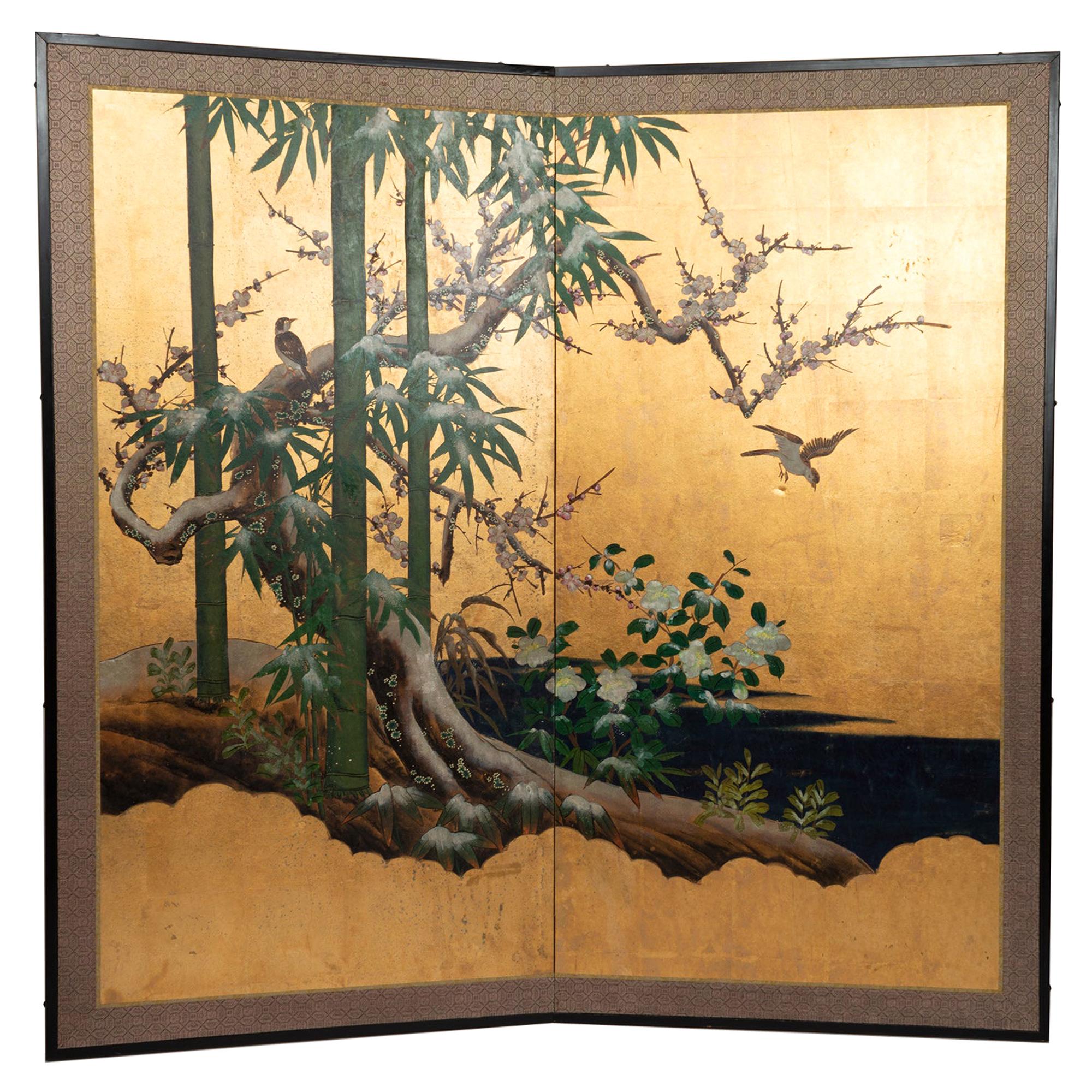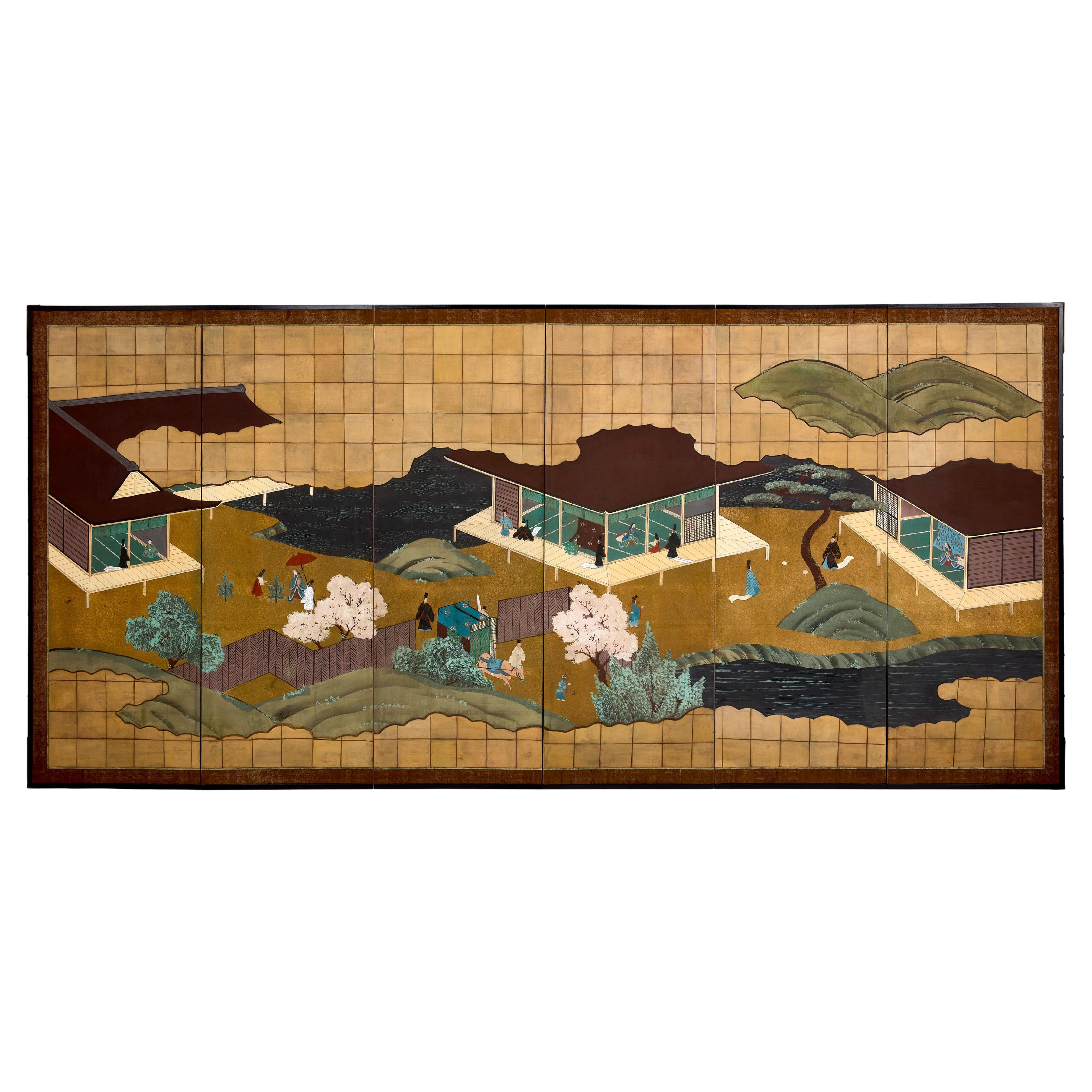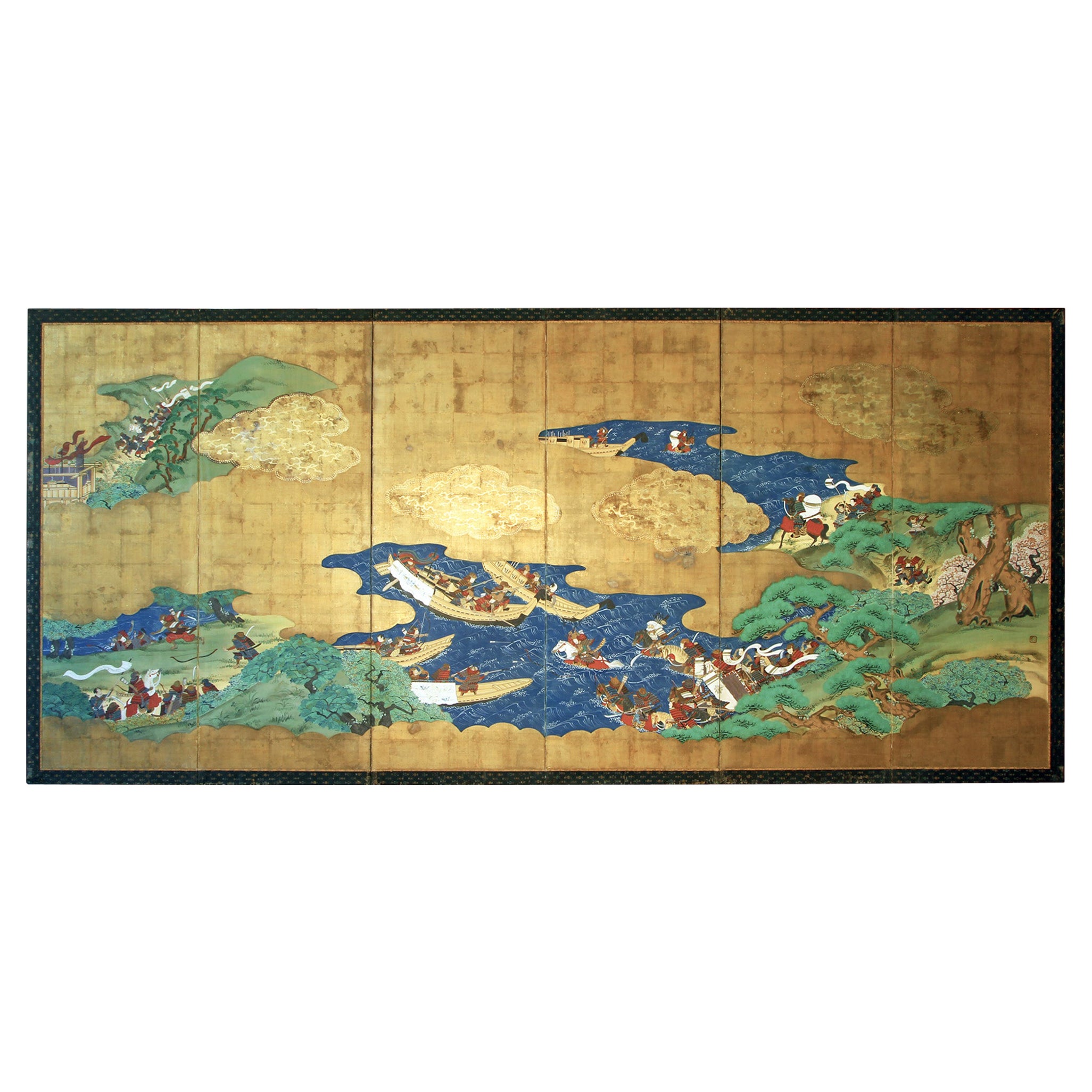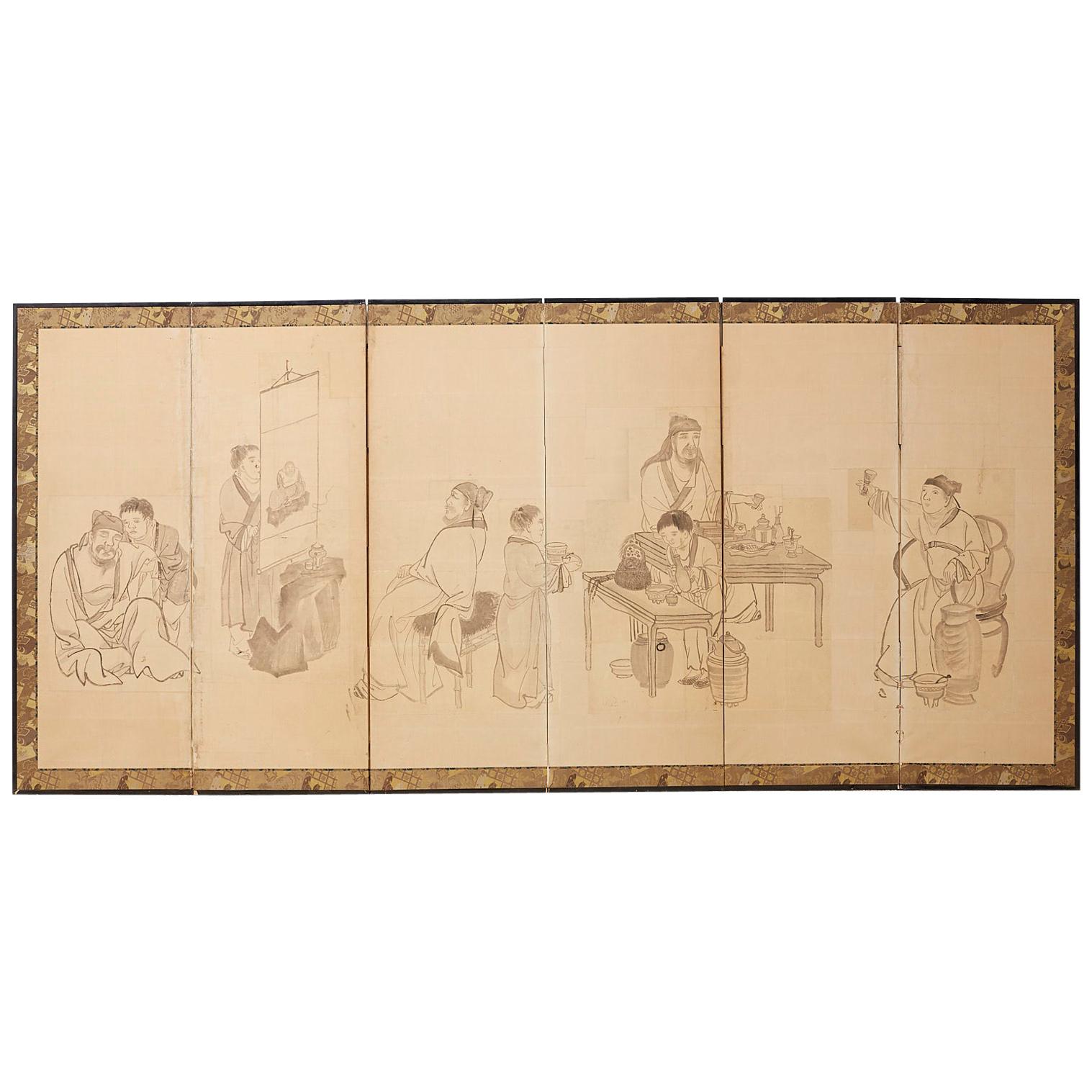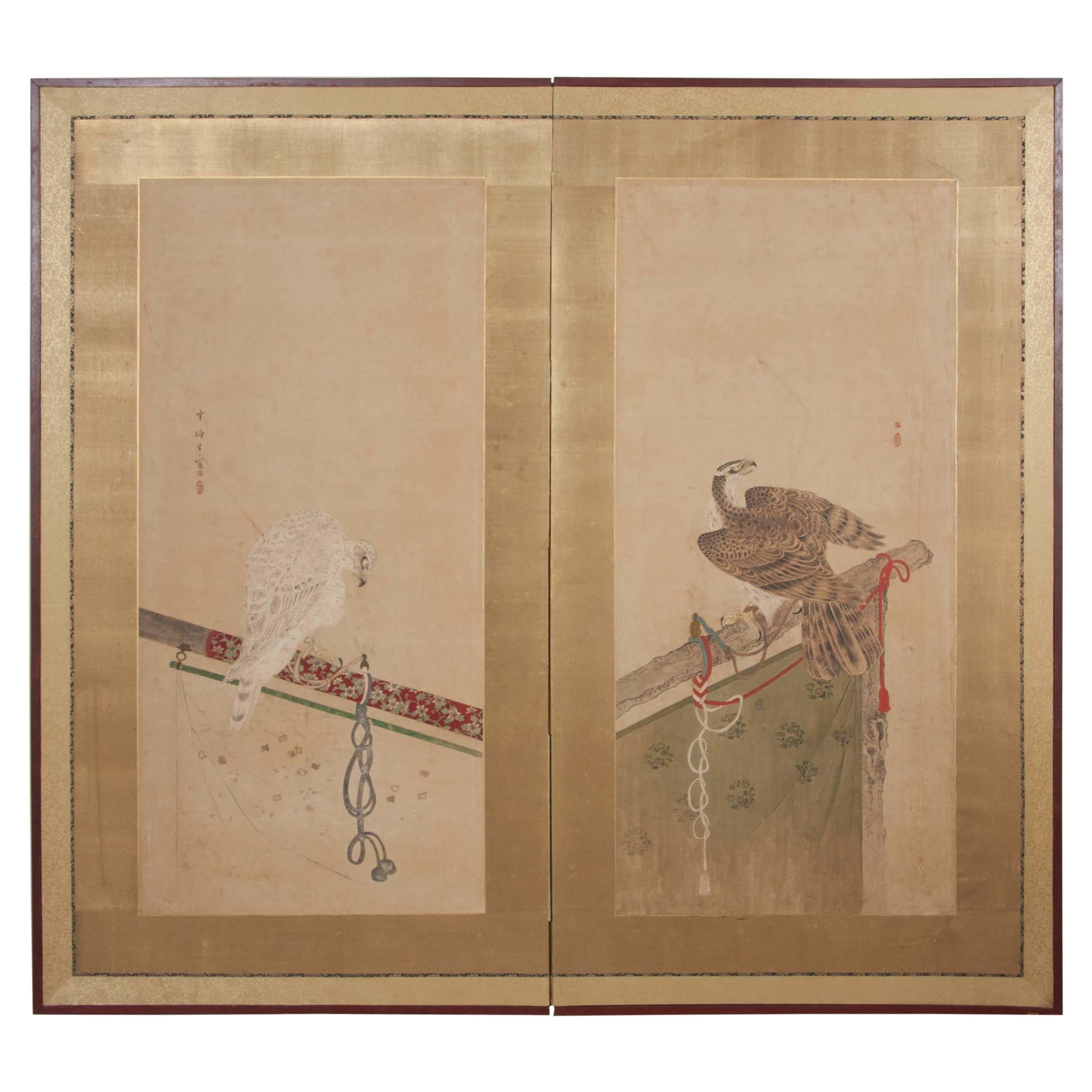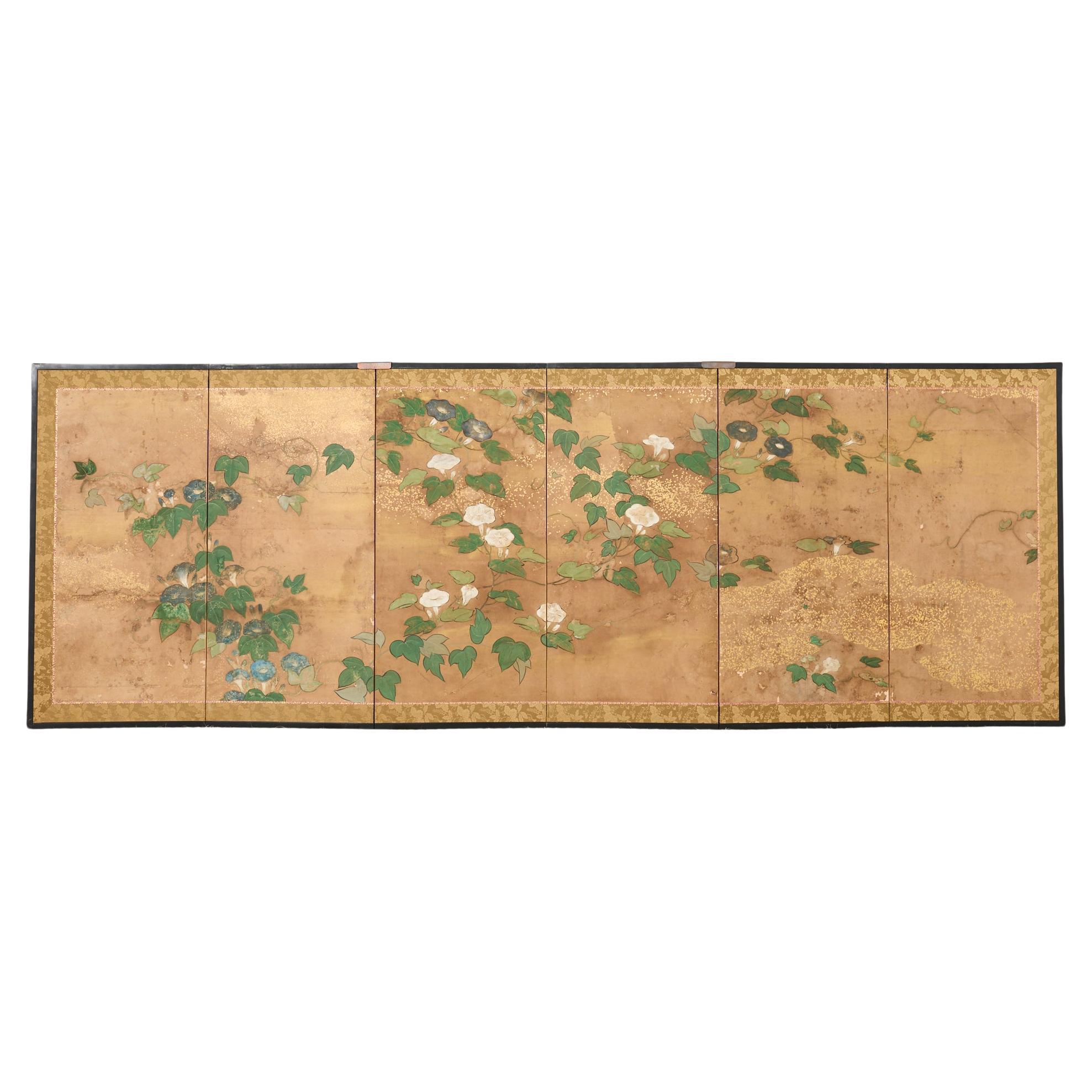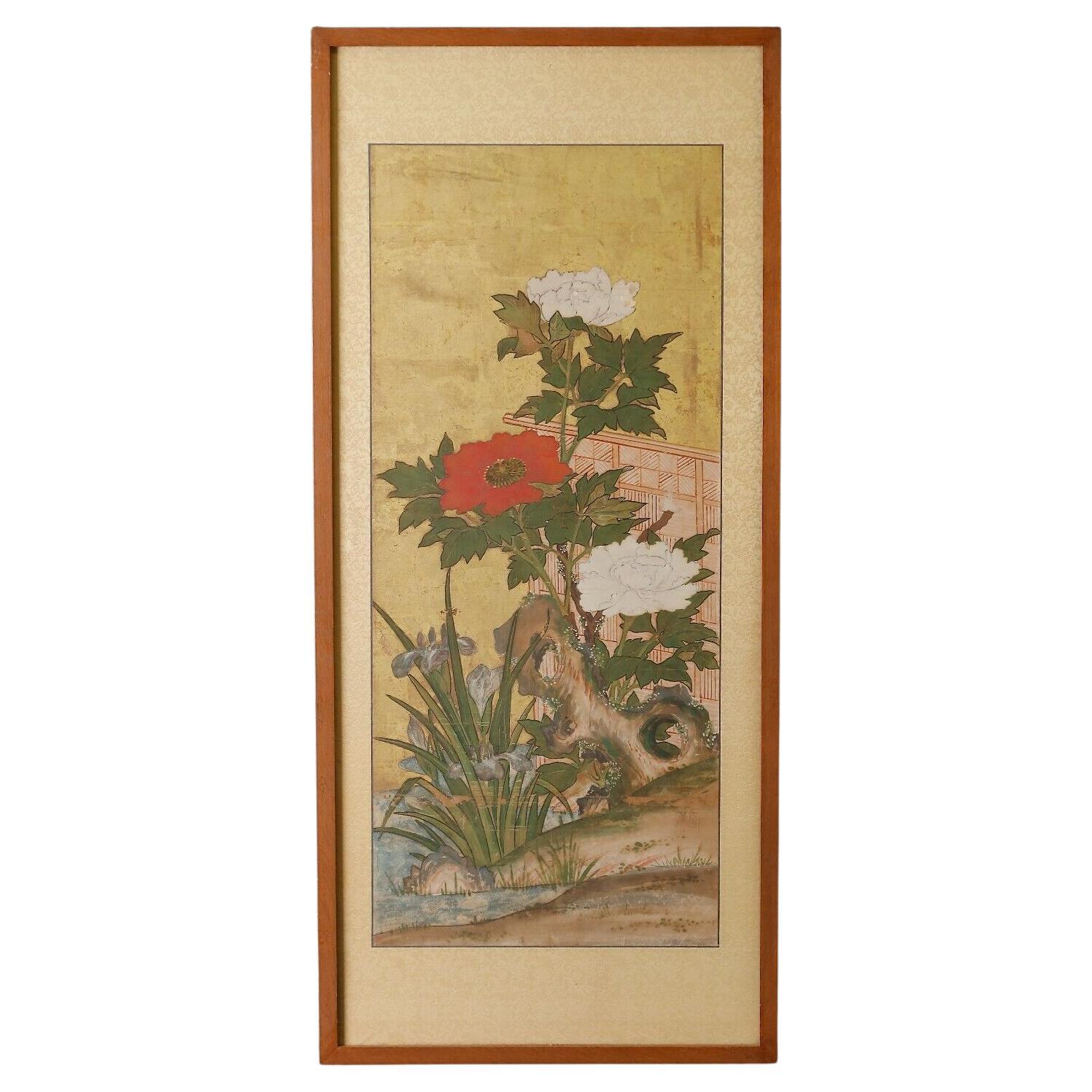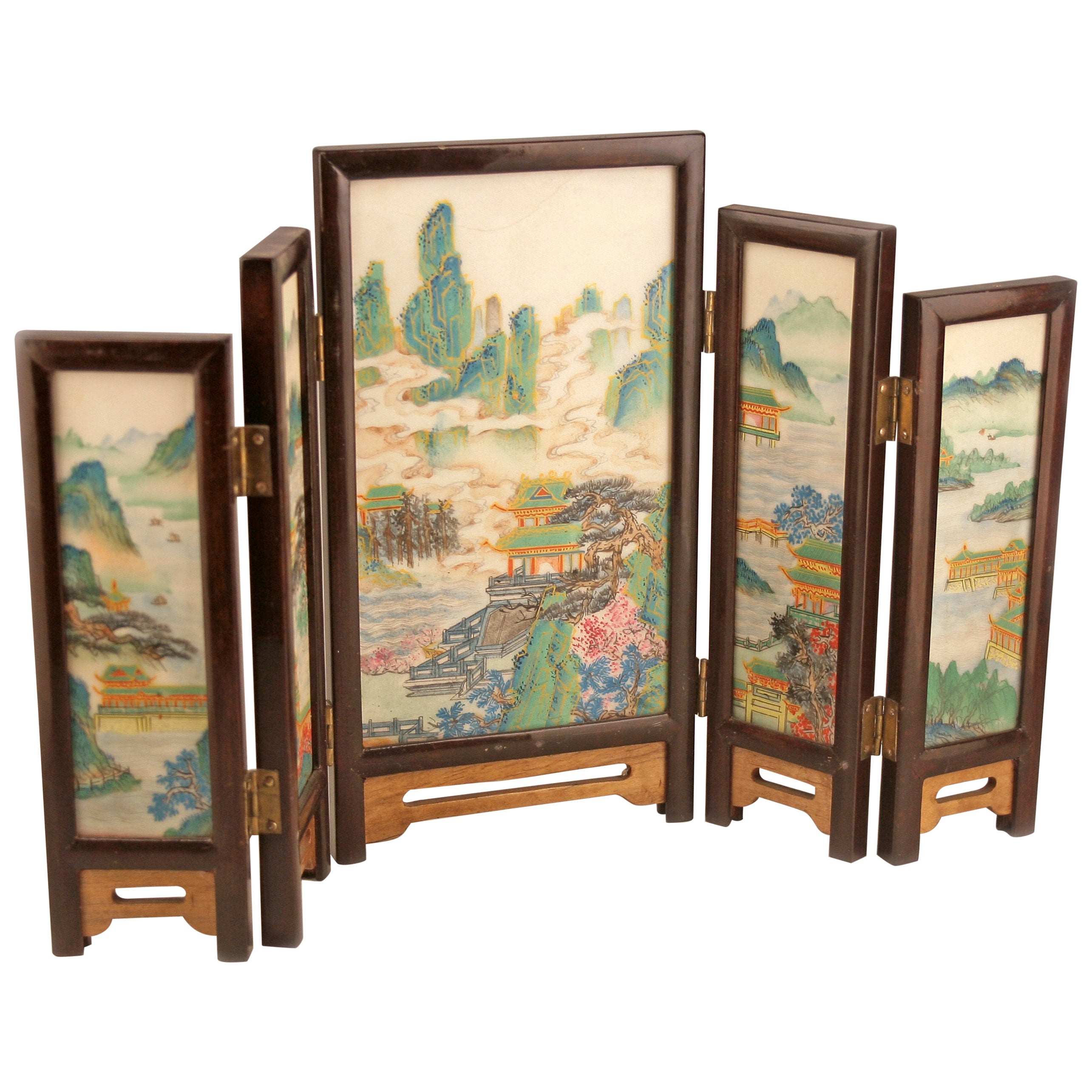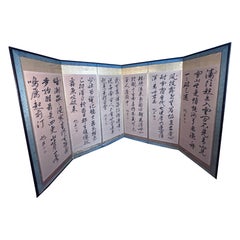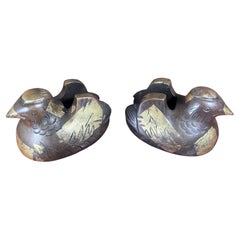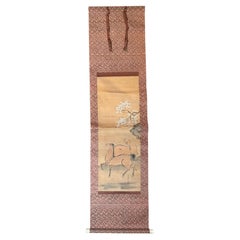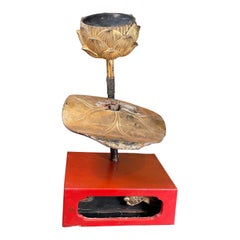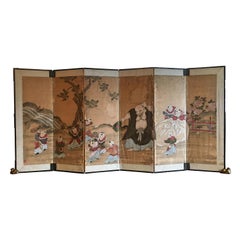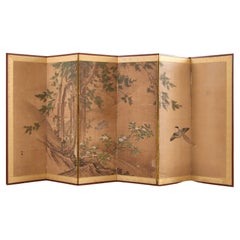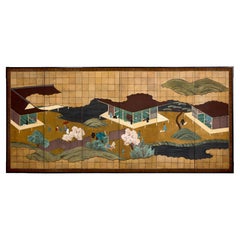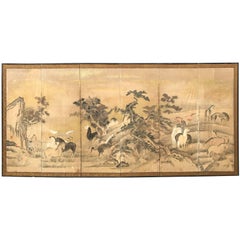
Japanese 22 Horses Fine Antique Six-Panel Screen, Edo Period, 19th Century
View Similar Items
Want more images or videos?
Request additional images or videos from the seller
1 of 21
Japanese 22 Horses Fine Antique Six-Panel Screen, Edo Period, 19th Century
Price:$2,149.77
$2,880List Price
About the Item
- Dimensions:Height: 68 in (172.72 cm)Width: 150 in (381 cm)Depth: 0.75 in (1.91 cm)
- Style:Edo (Of the Period)
- Materials and Techniques:
- Place of Origin:
- Period:
- Date of Manufacture:19th Century
- Condition:Wear consistent with age and use. some paint losses.
- Seller Location:South Burlington, VT
- Reference Number:1stDibs: LU1289211100201
About the Seller
5.0
Platinum Seller
Premium sellers with a 4.7+ rating and 24-hour response times
Established in 1990
1stDibs seller since 2015
2,386 sales on 1stDibs
Typical response time: 1 hour
Authenticity Guarantee
In the unlikely event there’s an issue with an item’s authenticity, contact us within 1 year for a full refund. DetailsMoney-Back Guarantee
If your item is not as described, is damaged in transit, or does not arrive, contact us within 7 days for a full refund. Details24-Hour Cancellation
You have a 24-hour grace period in which to reconsider your purchase, with no questions asked.Vetted Professional Sellers
Our world-class sellers must adhere to strict standards for service and quality, maintaining the integrity of our listings.Price-Match Guarantee
If you find that a seller listed the same item for a lower price elsewhere, we’ll match it.Trusted Global Delivery
Our best-in-class carrier network provides specialized shipping options worldwide, including custom delivery.More From This Seller
View AllJapanese Fine Antique Screen Hand Painted "Buddhist Nature" in Sumi Ink
Located in South Burlington, VT
From our recent Japanese Acquisition Travels
Praised as "the crown of poets from the eastern lands."
Japan, a good antique six-panel screen Byobu depicting hand painted on paper w...
Category
Early 20th Century Japanese Taisho Paintings and Screens
Materials
Paper
Japanese Fine Antique Pair Gilt Bronze Mandarin Duck Screen Holders
Located in South Burlington, VT
Best Quality, Hard To Find, complete with antique wooden collector box tomobako
A fine pair (2) of Japanese antique hand cast gilt bronze Mandarin Duck screen holders with highly d...
Category
Antique Late 19th Century Japanese Meiji Paintings and Screens
Materials
Bronze
Japanese Antique Bold Hand-Painted "Two Horses" Silk Scroll, Meiji Period
Located in South Burlington, VT
A bold, spectacular Japanese hand-brushed, hand-painted silk scroll of two horses below plumb tree mountain- worthy of your favorite room
Hand painting on silk in simple soft pleasin...
Category
Antique Late 19th Century Japanese Meiji Paintings and Screens
Materials
Silk
Japanese Fine Antique Gilt and Red Lacquer Lotus Bud Flower, Edo Period 19th C
Located in South Burlington, VT
From our recent Japanese acquisitions, a rare find
Antique Original Japanese temple "blossoming lotus" flower bud stem including its original red lacquer display base. This finely hand carved wood and lacquered gold flower stem was made for a Buddhist 19th century temple altar. Its flower blossoms and leaves symbolize the stages of the path toward enlightenment. The individual parts of each lotus is carved separately then joined in an arrangement and inserted in altar vessels.
Also called "Jyôka" , it is placed on or next to an altar in a Buddhist temple. Made with meticulous techniques. In Buddhism, the lotus is an important symbol of divine enlightenment because it blooms into beautiful flowers while growing in mud. Tsunehana means "a flower that continues to bloom forever" and "a flower that does not wither." For this reason, the flowers represented are in different stages of their life, unfolded lotus leaves, buds and full flowers, thus symbolizing the journey towards Buddhist enlightenment.
This lovely Japanese antique gilt Lotus flower is an early survivor, circa 1840, and a hard to find treasure that was originally placed on or around a temple altar.
This ensemble consists of a single stem, the top most flower, and the bottom leaf- all mounted in the original square red lacquer display base. A gold gilt 3.5 inch long tortoise "minogame" is affixed to the base as seen in the photo.
Its attractive original old patina coupled with much of the original gilding remaining present is just the way we like to find them.
Dimensions: With original red lacquer display stand Height, 17 inches height and 9 inches in width. The lotus flower stem alone measures 16 inches in height.
Provenance: acquired from a Kyoto Japanse monk and collector
History of the Japanese turtle "minogame"
One of the most famous is the mythological giant turtle...
Category
Antique 1840s Japanese Edo Sculptures and Carvings
Materials
Wood
Japanese Four Panel Garden Screen with Koi, Iris, & Turtles
Located in South Burlington, VT
Unusual Japanese Four Panel Garden Screen, Mint Condition
Japan, a superb four-panel silk screen byobu depicting a panoramic garden replete with koi, turtles, Iris nestled near a walking bridge and wooden roofed shelter. This attractive screen dates to the early Taisho period.
It is signed Tae.
It is beautifully hand painted with a handsome gold natural light background by a skillful artist painter and is signed with inscription and seal in lower right corner:
Dimensions: 69 inches high and 113 inches wide extended.
Enticing and rare subject matter, this simple rendition of a serene nature setting and size of painting is skillfully and tastefully rendered in mineral paint pigments on silk and with muted soft green and off-white tones depicting a serene nature walk. Perhaps this is someone's dream tea garden. A red lacquered wood perfectly frames this serene and tasteful composition.
Photographed in natural light.
Lifetime guarantee of authenticity: All of our Asian works of art come with our Lifetime Authenticity Guarantee. We are members of the North American Japanese Garden...
Category
Early 20th Century Japanese Taisho Paintings and Screens
Materials
Silk
$7,600 Sale Price
58% Off
Japanese Fine Pair Arts And Crafts Shoji Door Screens
Located in South Burlington, VT
Japan, a fine pair of two simple shoji bamboo doors or screens creating an arts and crafts look. The pair are hinged together for convenient display with attractive portals above; ...
Category
Early 20th Century Japanese Showa Paintings and Screens
Materials
Bamboo, Wood
You May Also Like
Japanese Six Panel Screen with Hotei, Edo Period, Early 19th Century
Located in Austin, TX
A delightful Japanese six panel painted paper screen featuring the beloved figure Hotei, Edo Period, early 19th century.
Hotei, called Budai in China, and known as the Laughing Buddha or Fat Buddha in the West, is considered to be an emanation of Maitreya, the Buddha of the Future.
In Japan, he also holds a special place as one of the Seven Lucky Gods, being the god of fortune, and protector of children.
He is always portrayed as a mirthful and corpulent man, dressed in loose robes that show off his round belly. He carries a sack with him, said to be filled with treasure. As the protector of children, he is often portrayed with them playing on or around him, as he is here. The children portrayed in this screen are dressed in Chinese style clothing...
Category
Antique Early 19th Century Japanese Edo Paintings and Screens
Materials
Silk, Paper
19th Century Japanese Edo Six Panel Kano School Landscape Screen
Located in Rio Vista, CA
Late Edo period 19th century Japanese six-panel landscape screen featuring a cypress tree over a flowering hibiscus with a pair of hototogisu birds. Kano school painted with ink and ...
Category
Antique 19th Century Japanese Edo Paintings and Screens
Materials
Silk, Wood, Paper
Antique 19th Century Japanese Two-Panel Screen ‘Byobu’, Kano School, Edo Period
Located in London, GB
Japanese Kano School Edo period two-panel screen depicting flowering prunus and bamboo on a rock formation, with colorful birds next to a body of water. ...
Category
Antique Mid-19th Century Japanese Edo Paintings and Screens
Materials
Gold Leaf
Japanese Byobu six panels screen on paper Edo Period 19th century
Located in Paris, IDF
Beautiful Edo period Japanese Byobu six panel screen from the early 19th century depicting scenes from the Tale of Genji, with pavilions, gardens and women of the court wearing kimon...
Category
Antique 19th Century Japanese Japonisme Paintings and Screens
Materials
Paper
Edo 19th Century Japanese Folding Screen Six Panels Battle of Menpei
By Japanese Studio
Located in Brescia, IT
Samurai on horseback and by boat from the famous battle of Menpei Japanese folding screen six-panel of "Tosa School" painted with mineral pigments on vegetable on golden silk , earl...
Category
Antique Early 19th Century Japanese Edo Paintings and Screens
Materials
Gold Leaf
Japanese Edo Period Six Panel Screen of Chinese Scholars
Located in Rio Vista, CA
Fascinating 19th century Japanese late Edo period six pane funpon screen. Large scale depicting Chinese scholars and officials engaged in leis...
Category
Antique 19th Century Japanese Edo Paintings and Screens
Materials
Silk, Wood, Paper
Recently Viewed
View AllMore Ways To Browse
Six Panel Byobu
Horse Panel Screen
Japanese Horse Painting
Painted Panel Screen Horses
Japanese Antique Byobu
Japanese Screen Horses
Scrolls Art
Asian Art Framed
Asian Art On Paper
Japanese Hand Painted Art
Asian Art Screens
Japan Gold Painting
Japanese Gold Paintings
Japan Antique Paper
Japanese Art Trees
Hand Painted Silk
Japanese Panels
Japanese Screens


